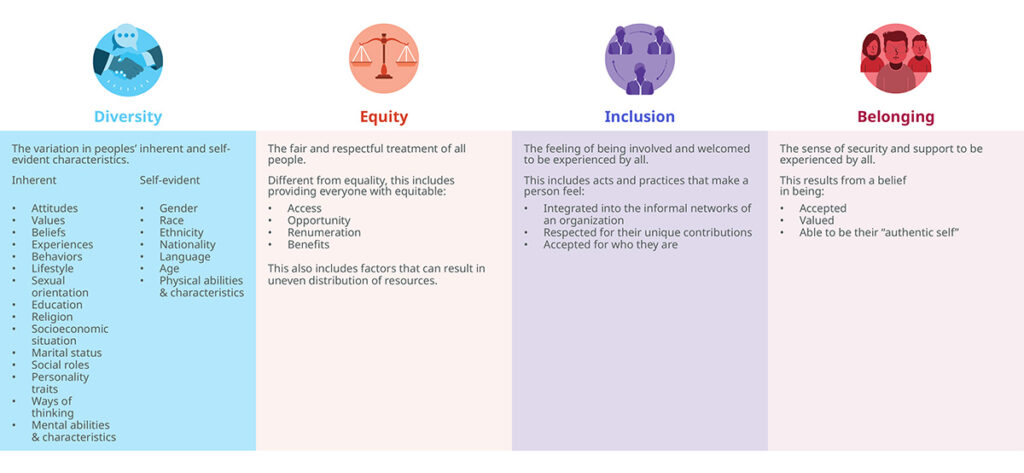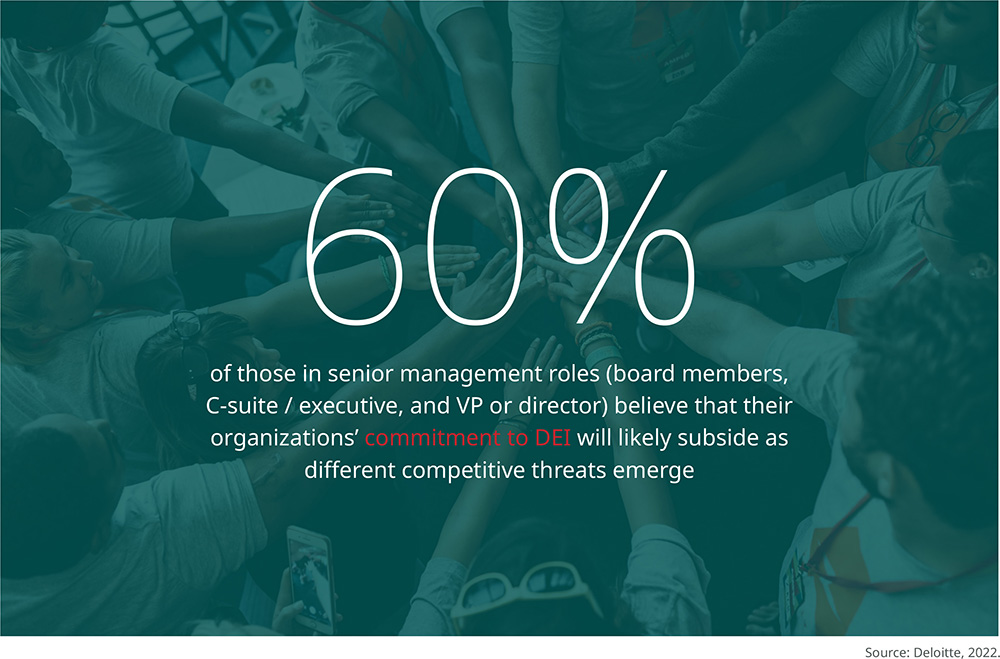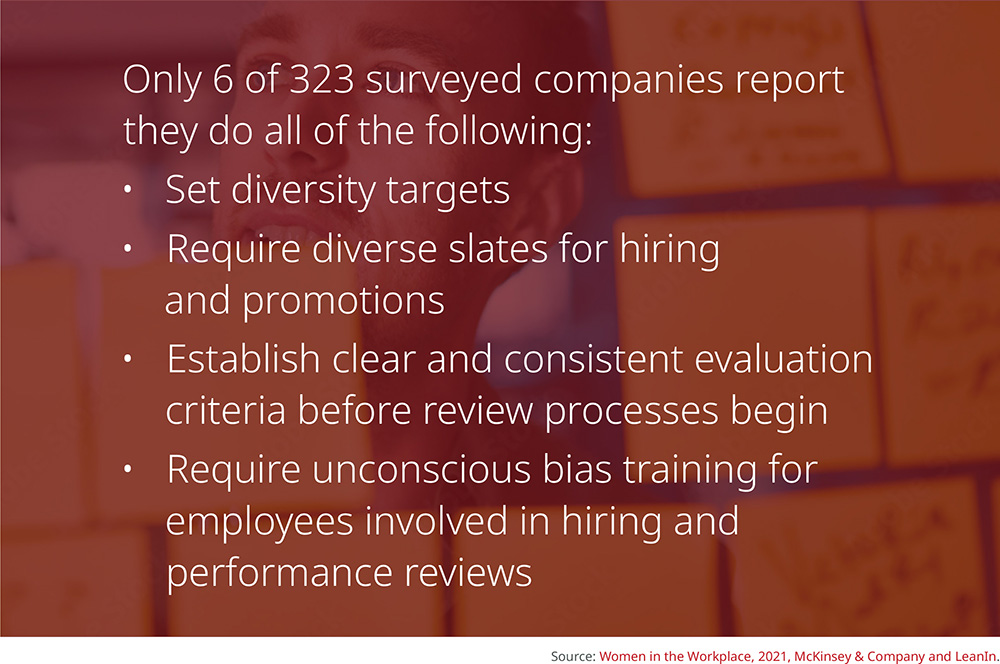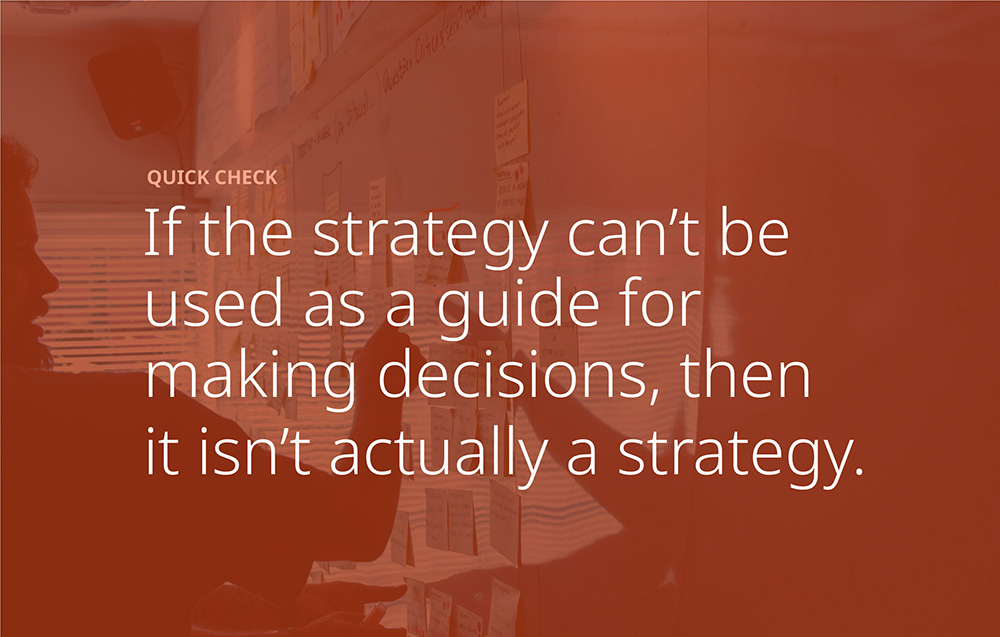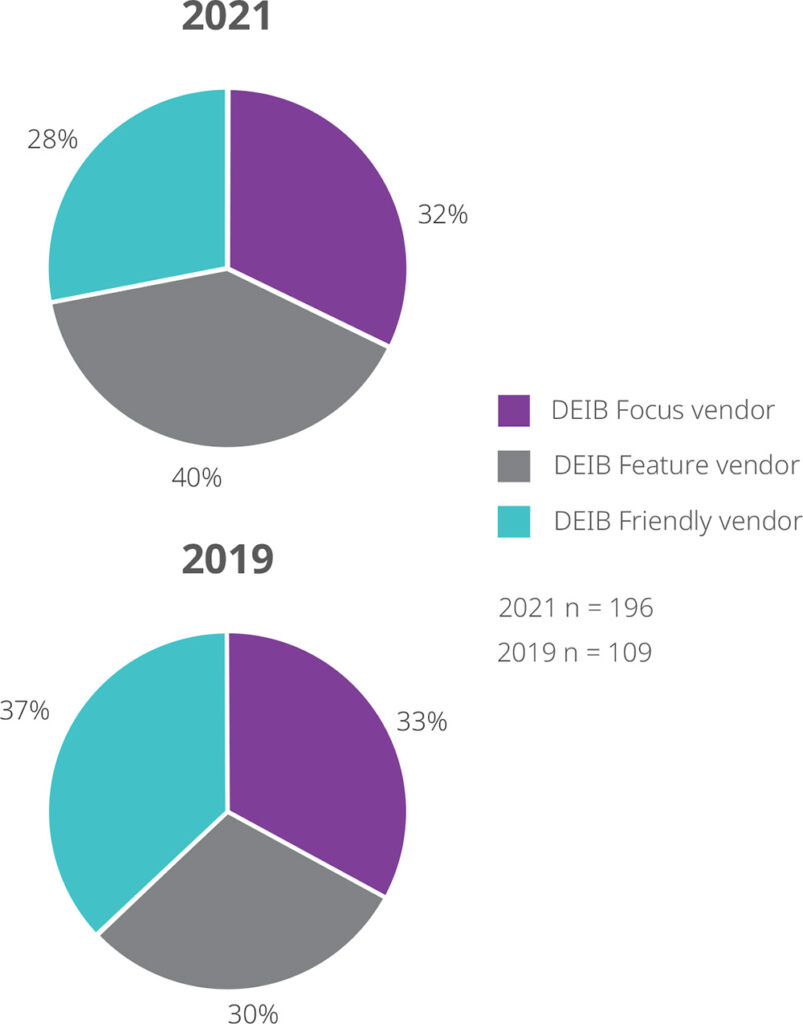Diversity, Equity, Inclusion & Belonging: Designing for a Post-Pandemic World
July 12th, 2022
Download This Research[/button]
Organizations still have a long way to go when it comes to DEIB
It's been more than 2 years since the murder of George Floyd. Two years since business leaders published statements promising to address the systemic inequities within their organizations. Two years since organizations began hiring new diversity, equity, inclusion, and belonging (DEIB) leaders, reexamining practices, and investing in new programs and systems. So, what results have we seen?
To date, the results of these actions haven't been great. According to the Edelman Trust Index, most employees under age 54 don't believe that companies are living up to the promises made to address racism within their organization. Further, trust in employers to respond appropriately to systemic racism and racial injustice has declined. As shown in Figure 1, this is particularly the case in populations impacted by racially motivated events, such as the mass shootings of Asians in Atlanta, GA in March 2021, Taiwanese in Laguna Woods, CA in May of 2022, and of Blacks in Buffalo, NY also in May of 2022.

Figure 1: Perceptions of trust among U.S. employees toward their employers | Source: Edelman, 2022.
Though issues of race are the most prevalent at the moment, they're not the only areas for which employees are dissatisfied with their employers’ responses. For example, data from PwC shows that 80% of employees believe their organizations don’t gather and analyze data on compensation, performance, hiring, and promotions discrepancies. Further, nearly 40% of total respondents from a survey of 1,543 workers, the majority of whom identify as Black, Hispanic / Latinx, Asian, female, and LGBTQIA, believe their company’s commitment to DEI is likely to drift in the future.
Even CEOs recognize the problem: According to Deloitte, 41% believe there's a lack of trust around DEI in their organizations.
“The taken-for-granted assumption that one could just get a position of leadership and then behave however one chooses to and get away with it…is not really panning out. The context has changed.”
—Laura Morgan Roberts, Professor, University of Virginia, Darden School of Business
Employees still expect organizations to act
Despite employees’ dissatisfaction with their organizations’ progress over the last few years, they still expect companies to take action on issues of racial injustice. Americans still trust their employers more than any other type of institution to do what's “right” when it comes to racism. Similarly, 66% of Americans think businesses should act on racial injustice issues, while 68% believe people should be able to discuss the topic at work (see Figure 2).

Figure 2: Expectations of employers by employees on racial injustice issues | Source: Paradigm, 2021.
Further, 58% of the U.S. general population indicate that an inclusive work culture with a strong and well-supported diversity program is critically important to attract and retain them. Further, in organizations that have made “a lot” of progress in addressing racism and racial inequities in the workforce, employees have higher levels of loyalty, employer advocacy, and commitment.
The questions this study answers
Given everything that's happened in the last few years, we took a step back and asked a few critical questions:
- What are some of the fundamental shifts we’ve seen related to talent—and how will this impact diversity, equity, inclusion, and belonging (DEIB)?
- What is a holistic way leaders can think about their DEIB efforts, thereby more effectively defining and integrating their DEIB strategy with other activities?
- What trends do we see moving forward that could influence organizations' 2022-2023 strategy?
This study is based on a review of more than 70 articles, and interviews with 10 DEIB leaders and 20 HR leaders.
RedThread's definitions of terms: DEIB
Fundamental shifts
The earthquake beneath the talent landscape is shaking up DEIB expectations
Over the last few years, we’ve seen some tectonic-level shifts in the talent landscape. These include:
- Change in power dynamics in favor of Over the last year, we’ve seen the Great Resignation as well as a massive rebellion when it comes to employees returning to the office (office occupancy rates have plateaued at 43%). Further, the gig marketplace and alternative work arrangements are increasingly attractive to employees, with many opting for those roles in lieu of a corporate job.
- Demand for skills that are in under-supply results in a greater focus on retention, promotion, and talent The last few years’ whiplash-like changes in the business environment have highlighted organizations’ talent deficiencies. Leaders realize they don’t have the skills they need in their existing workforce—and they can't fill their organizations’ demand for skills from the external talent market. Therefore, leaders are focusing on retaining employees and developing them with the skills the company needs.
- Rising importance of human capital For companies, more and more of their business is people-driven, resulting in investors taking a growing interest in human capital metrics. The SEC, for example, is now requiring public companies to report on those metrics—including diversity metrics—in their financial reports.
As a result of these major shifts, leaders could not simply make their 2020 DEIB promises and move on to the next thing (see Figure 3). Instead, they see a situation in which:
- Employees feel empowered to demand change with Nearly 60% of those aged 35-54 and 70% of those aged 18-34 have advocated or acted against racism—and they're carrying those expectations of action into their workplaces. Another 82% of employees expect CEOs to do something to address systemic racism and racial injustice.
- Leaders must respond to employees’ demands to make progress on It’s clear that leaders must address racism or risk losing employees. While 40% of employees would consider leaving their company if they don’t trust it to fulfill its DEI commitments, 56% would not recommend their company as a place to work.
- The public is monitoring progress on With the current SEC requirements to disclose diversity data—and more requirements coming soon—investors, employees, and the media are all holding leaders accountable for moving the needle on DEIB metrics. While some organizations have shared minimal diversity data, it’s unlikely that scenario will remain tenable.
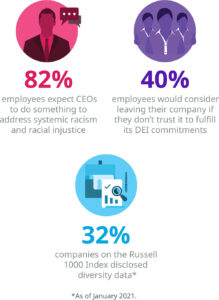
Figure 3: Leaders need to follow through on their DEIB promises | Source: Edelman 2022, Deloitte 2022, Just Capital 2021.
“A role that was once focused on race and gender has grown in complexity and inclusion of individuals spanning military status, special needs, LGBTQ, generations, and more. What was once a focus on workforce (people) now includes workplace (culture) and marketplace (business).”
—Jackson Lee Davis IV, Head of Diversity, Equity, and Inclusion, MassMutual
Real-World Threads
Gentech and Chipotle make DEIB everyone’s job
DEIB isn't the sole responsibility of human resources. In 2019, Genentech CEO Alexander Hardy created the role of chief diversity officer (CDO) and decided it should report directly to him. Additionally, managers of departments are required to complete D&I action plans that are then shared with their teams and, in some cases, the entire company on its intranet. The departmental action plans help create ownership so that it's not just the CDO’s responsibility to drive D&I.
These steps have allowed the company to expand its commitment to D&I beyond hiring and retention, and into every aspect of its business and company culture.
Similarly, at Chipotle the diversity strategy is not seen as a responsibility of one department. The company’s program includes mentorship, virtual roundtables, and quarterly training. For the company, the most effective programming is an ongoing cadence of events that genuinely engage its workforce and features a diverse group of individuals from various departments. It believes that when employees make real connections, it helps cultivate an environment where they can thrive and pursue their passions with like-minded coworkers.
“Prior to the creation of the Chief Diversity Office, our D&I efforts sat within HR. Alexander understood the need for an enterprisewide mindset and a seat at the decision-making table for us to think bolder than representation—and truly advance equity within Genentech’s business.”
A shift within a shift: The rising importance of purpose
An underlying theme of the shift in power dynamics toward employees is their greater desire to align their personal purpose with the purpose of their respective organizations. According to Gartner, as of January 2022, within the U.S. employee population:
- 52% question the purpose of their day-to-day job
- 56% want to contribute more to society
- 65% are rethinking the place work should have in their lives
Leaders increasingly understand the need to identify, articulate, and act on their organization’s purpose. As identified in Figure 4, an organization's purpose is a clear and concise statement that inspires people to deliver value to multiple stakeholders.
An organizational purpose that considers multiple stakeholders—also known as stakeholder capitalism—is not some new-fangled idea that some fringe companies are doing. In fact, the Business Roundtable, an organization comprised of the largest companies in the world, released an updated “Statement on the Purpose of a Corporation” in August 2019.
In this statement, “181 CEOs committed to pursue a more holistic approach to serving stakeholders more broadly renouncing the concept of shareholder primacy.”
Organizational purpose: A clear and concise statement that inspires people to deliver value to multiple stakeholders.
Purposeful organizations focus on the same stakeholder types as DEIB leaders
The focus on purpose has a direct consequence for DEIB efforts, as the multiple types of stakeholders identified by the Business Roundtable (see Figure 5) are the same ones on which DEIB leaders traditionally focus.
This means that DEIB leaders should have more support for their efforts, as organizations try to fulfill the idea of organizational purpose.
But with that broader support also, potentially, come more cooks in the DEIB kitchen—and more scrutiny of DEIB efforts. This makes it more important than ever to have a clear and holistic approach to DEIB.
Developing a holistic approach to DEIB
“This work is about culture and change management, and so we need to be looking for behaviors, practices, or norms that need to change.“
—Mary Ellen Connerty, Director, Diversity & Engagement, O’Melveny & Myers LLP
Creating a holistic DEIB approach
When you’re developing a new DEIB approach—really a DEIB system—you need to answer these 6 questions (see Figure 6):
- Why is my organization focusing on DEIB?
- What goals are we trying to achieve and for whom?
- What is our strategy to achieve those goals?
- What levers are we trying to pull to enable that strategy? What are the supporting activities that pull those levers?
- How will we use technology to scale our operational activities?
- How will we use data, analytics, and metrics to create transparency and enable accountability?
A holistic DEIB system is one in which every organizational process, action, policy, and decision is looked at through a DEIB lens.
Start with your organization’s “why”
There are typically 3 reasons why organizations focus on DEIB:
- Alignment to organizational purpose
- “Right thing to do” (RTTD)
- Business case for D&I
Right now, though, there’s another reason:
Other competing priorities. A recent Deloitte study revealed that majority of senior leaders believe their organizations' commitment to DEIB will take a back seat as other competitive threats surface.
This skepticism of organizations’ commitment to DEIB means it's even more important than ever for organizations to follow through on their commitments.
Making it happen: Understanding the why
When you open the discussion to “why” your organization is supporting DEIB, it's critical to be sensitive to the organization's specific context, environment, and leaders’ perspectives.
Different leaders are at various stages in their journey to understand and embrace DEIB. One of the benefits of the greater openness we’ve seen is that many leaders are now more open to further learning.
Regardless of specific leaders’ perspectives, the important thing is to align on the overall why for the company.
“Begin with why this is important to you. Align it to the long-term value of the firm, the purpose of the firm, and your value system.”
—Mary Slaughter, Former Managing Director, EY
Why: A checklist to jumpstart your efforts
❏ Why are we focusing on DEIB (i.e., alignment to purpose, market / societal expectations, business outcomes)?
❏ How does that reason align with our business strategy?
❏ How does this reason(s) align with our internal talent expectations and our external brand?
❏ What are the specific DEIB changes that impact our organization?
❏ What are senior execs’ experiences with DEIB and how can we use those to align on a vision?
What does your organization want to achieve?
The next big question to answer is what your goals are, both long term and short. Some examples of typical goals we heard are:
- Ensure talent pipeline diversity
- Move the dial on leadership diversity
- Identify barriers to belonging while putting inclusive practices in place
- Enhance representation among middle management
It’s important to be very clear on these goals, and (as we discuss later) to have clear metrics and accountability in place for these goals.
Real-World Threads
TD bank conducts an audit to review internal DEIB policies
Canada’s Toronto-Dominion Bank (TD Bank) has created goals for the company for 2025 to increase the representation of Black, Indigenous, and minorities at the vice-president level or higher. To achieve that, the company began by conducting its first-ever racial equity audit in 2022.
The audit will scrutinize TD’s internal employment practices for racial bias and allow the bank to use its findings to inform future business practices with Black, Indigenous, and other racialized customers. It includes a third-party assessment by an outside law firm and TD staffers' contributions.
The purpose of the audit is to help the bank review its employment policy and understand how it operates. The bank is also committed to applying the lessons learned in its work with customers and communities. While the company started by looking at its operations and employee experience at the bank, its DEIB strategy has expanded to include how it interacts with and serves its customers and communities. The company’s approach to DEIB recognizes the intrinsic link to other dimensions of its business, and the impacts of racial equity on customers and communities.
In addition to focusing on representation, the company also tracks inclusion through an employee experience survey that it reviews from the perspective of different communities to understand the experiences of Black, Indigenous, and underrepresented employees at TD.
“If you don’t have that strong, inclusive culture within your organization, if you don’t have an understanding of how racism and discrimination can manifest—including in the form of microaggressions—then you’re not going to be able to achieve that sustainable progress you want to see.”
—Diana Lee, Vice-President of Diversity and Inclusion, TD Bank
And, for whom?
While it’s important to have high-level goals, you should consider focusing on goals for specific subsets of stakeholders (see Figure 7).
For example, you may have specific goals for C-suite leaders and middle managers, as those groups are critical to making DEIB a reality.
In addition, you may have goals for specific demographic groups, such as gender, race / ethnicity, culture, sexual orientation, social / economic classification, age, disability, and religion.
For the last few years, there’s been a huge focus on both female and Black employees. We expect to see goals around representation and engagement of these populations to continue.

Figure 7: 5 stakeholders of organizations, including DEIB subgroups | Source: RedThread Research, 2022.
Making it happen: Listening for better goal-setting
When setting goals, it's essential for you to understand the range of perceptions and experiences of different stakeholders. This can mean leveraging a range of data sources (e.g., interviews, focus groups, surveys, demographic data, digital exhaust, etc.) to get a holistic picture of current state and gaps.
Recommendations and feedback from diversity councils, resource and affinity groups, people committees, and diversity advocates comprise an integral part of understanding where you stand and where you need to go.
“Every strategy must start with listening. We must veer away from making assumptions on what people need and how they need it, and listening forms a core part of that.” —Sheree Atcheson, former Global Director of Diversity, Equity and Inclusion, Peakon
Goals: A checklist to jumpstart your efforts
❏ Where are we currently?
❏ Where are the existing gaps?
❏ What is the experience of each of our stakeholders in working with our organization?
❏ How frequently are we listening to stakeholders?
❏ Are there specific roles or groups, such as executives or middle managers, whose approach needs to evolve so we can drive change?
❏ What has changed and are we addressing that in our goals?
❏ How will the goals we set align with our business strategy and objectives?
“Understand the business you’re in and figure out how D&I can enhance the bottom line. Such efforts can’t be an HR initiative; they ca be separate from corporate strategy. This is about engaging the entire organization on issues related to diversity.”
What is a strategy anyway?
We have read about a lot of different DEIB “strategies”:
- The 3 Ps: People, partners, and places
- The 4 Pillars: Workforce, workplace, industry, and community
- The 3 Is: Individuals, infrastructure, and impact
While these are useful methods to keep track of all the ways you can operationalize a strategy, they are not a strategy.
Instead, a strategy helps you understand what you should be doing—and, as a result, what you should not be doing—to achieve the established goals.
A DEIB strategy supports the purpose and drives the organizational culture.
Think of it this way: Your strategy to win a marathon may be to go fast the first 13 miles and slow the last 13 miles (and just hope you make it!). Or it could be to go slow the first 20 miles and sprint the last 6.
But a strategy wouldn't be to put on your running shoes, clothes, and drink water! They may be necessary to running the race, but they're not your strategy.
A business strategy is “… a set of guiding principles that, when communicated and adopted in the organization, generates a desired pattern of decision making.” Source: Harvard Business Review, 2007.
So what’s a DEIB strategy then?
A DEIB strategy, similarly, is a set of guiding principles that helps your organization achieve its DEIB goals. The DEIB strategy should help you make decisions about the activities to engage in and those you should forego to achieve your goals.
What does this look like in real life? As an example, let's assume a company’s goal is:
“To be the most inclusive organization in tech.”
Sounds lofty, right? Well, then the strategy could be:
“To create inclusive experiences for employees from their first interaction to their exit interview.”
This strategy clarifies that the organization will focus on all of the talent lifecycle and specifically focus on inclusion (diversity, equity, or belonging may be a secondary focus).
It also gives the organization a set of guidelines for making decisions, for example:
- Is this talent selection process inclusive? Nope? Let’s change
- Is this leadership program inclusive? Kind of. Let’s evolve it.
- Is this event inclusive? Yes! Great, how can we do more of them?
How are DEIB strategies changing now?
We asked every interviewee if their DEIB strategy is changing and the results were mixed.
Organizations that already had a clear strategy indicated they plan to stay the course. These companies have amplified their efforts for Black employees and their communities, but haven't planned significant strategic changes.
"Having a collective strategy around what we’re doing not only to hire the best talent but also to retain talent and develop talent is important. One of the reasons we’re seeing strong results is because of how we’ve treated our people , and a lot of that has been led by HR."
—Cynthia Bowman, Chief Diversity and Inclusion and Talent Acquisition Officer, Bank of America
For those organizations that are relatively early in their DEIB journey, we find are much more likely to indicate they're planning to adjust their strategy. Generally speaking, this means developing a much more explicit focus on inclusion and belonging for Black employees, and a greater level of openness for difficult conversations about racial justice.
" to make sure we’re talking about inclusion and equality at every level, and that it is front and center in the board room and in the management room. We can set hard targets for ourselves and make those transparent to our board and measure them like we measure other outcomes like financial results.”
Strategy vs. goals: What’s the difference?
Once you've set your goals, the next step is to figure out how to achieve them and lay out a strategy for it. You may fall short at this stage as setting goals and objectives is often confused with an actual strategy.
While DEIB goals are what you hope to achieve, a strategy is a specific action plan that will help you get there.
It's critical that you be extremely detailed and descriptive in laying out the specific targets and how you strategically work to achieve them. Unlike goals, which can be both short and long term (1-5 years), a strategy should cover a short-time period (e.g., 1 financial year) and needs to be revisited often.
" You can’t take exactly what someone else is doing, put it in your organization and think it will work. You’re not really focusing on your own culture and diagnosing your own issues. You can learn what others are doing, but you have to figure out what challenges you’re trying to solve for your own company.”
—Monica Jackson, Vice President of Inclusion and Diversity, Eaton
Real-World Threads
Building on progress through conversations at Bank of America
Bank of America’s commitment to DEIB is reflected in its numbers. Its global workforce is half women, and in the U.S., 49% of its workforce are people of color. Half of the company’s board of directors is diverse, and it’s among just 9 S&P companies with at least 6 female board members. In 2021, the bank increased its commitment to racial equality and economic opportunity to $1.25 billion over 5 years.
One of the ways the bank builds on its diversity efforts and advances that success is through its “Let’s Get Real” courageous conversations series. These conversations allow employees to empathize, understand their differences, and contextualize some of the takeaways and lessons. Held across the organization globally, the conversations are led by members of the board, the CEO, most of the management team, multiple employee networks, and many employees who’ve been able to talk about the issues that matter to them.
The conversations cover different topics—intersectionality, mental health, equity, and inclusion—and have helped people check their own biases and reflect on how to be more consciously unbiased. Another area is helping people get comfortable with difficult conversations and providing them with the necessary tools to talk about sometimes difficult topics to drive more conversations around inclusion and equity.
Bank of America encourages its people to be proactive and have deliberate conversations. It wants them to listen to others instead of replying right away, and challenge themselves to see where that person is coming from. The bank encourages people to have authentic conversations.
Making it happen: Refining the strategy
Similar to goal-setting, involve different stakeholders right from the start in refining the strategy.
Incorporate different groups with varied experiences to get their perspectives on how goals can be achieved. Strategy setting should be a highly iterative process.
Our interviews revealed 3 findings crucial to this step:
- Collaborate with business leaders on how the DEIB strategy will work for their business and enable them to achieve their objectives
- Work with HR and other teams, such as talent acquisition, learning and development, and leadership development, to revisit policies and practices to ensure that the strategy is baked into every process
- Using the strategy setting process—and the resulting communications—as a way to get everyone onboard with the actions to come
Strategy: A checklist to jumpstart your efforts
❏ Who needs to be involved in creating the strategy (including middle and frontline managers)?
❏ Do our goals and strategy support each other?
❏ What specific activities will help us achieve those goals?
❏ What practices / policies need to be shifted?
❏ How can we embed DEIB strategy and activities into the business strategy?
❏ Does the strategy align with the overall purpose of the organization?
“Solving DEI&B starts with understanding the human brain and how we relate to one another. If we don't learn how to talk openly about this complex subject, if we don't learn how to spot bias in our own behaviors, and if we don't learn how to act inclusively and have empathy for others, all our procedures in the world won't change our individual experiences.”
—Mary Slaughter, Former Managing Director, EY
Moving on from strategy: Focus first on the levers, not activities
It’s super easy to rush from strategy to specific programs, initiatives, and events. Don’t make this mistake.
Instead, identify the levers your organization most needs to focus on to drive DEIB outcomes (see Figure 8). This allows you to be more purposeful about your organization's DEIB activities.
For some goals, it may be best to focus on some of the levers, while, for others, you might want to influence all of them.
For example, if your organization’s challenge is senior leaders' support, then you might want to focus on understanding those leaders’ individual beliefs / behaviors, and making low-risk policy or program changes. If, instead, your challenge is middle-manager support, then you might focus on understanding those leaders’ beliefs and behaviors, but also tackle driving changes in all other areas, too.
Select DEIB activities based on levers
Once you’re clear on the levers you're trying to influence, then identify the activities that could be appropriate. Figure 9 offers an example list of activities that impact DEIB levers. This list is not exhaustive. You should build out your own list—and adjust your assessment of the extent to which the activities influence the levers for your organization.
Generally speaking, it's better to have activities that influence multiple levers. That said, a specific talent activity may serve an important purpose for a single lever.
For example, a statement on the organization’s perspective regarding racial injustice during the summer of 2020 was incredibly important. However, since it only influences one of the levers, it needed to be backed up with other activities that can impact DEIB outcomes.
Real-World Threads
DoorDash promotes internal talent through its “Elevate” program
In early 2019, DoorDash, the food-delivery startup, implemented a DEIB program, Elevate, an internal sponsorship project designed to help advance the careers of women of color.
Because the executive team was already convinced about the need for such a program, leadership buy-in was quick. However, the program founders spent significant time educating leaders on the differences between mentorship and sponsorship. Specifically, they clarified that managers may offer support, training, advice, and coaching as part of mentorship, but a sponsor should also be an active advocate.
The program is designed for women of color who aspire to hold leadership positions. Participants (called fellows) receive sponsorship from senior management for 6 months. The fellows engage in several activities throughout the program, including attending:
- One-on-one coaching sessions with an external executive coach
- Executive sponsor meetings with company directors and C-suite members
- Career workshops
- Leadership team meetings
The activities aim to help them gain visibility, understand the language leaders speak at that level, and widen their network.
To track success, the company runs surveys before and after each program iteration. The surveys measure satisfaction rates for participants, including what they thought of the coaching and their sponsor. It also tracks retention and promotions of attendees, as well as internal mobility.
After 3 cohorts, Elevate has shown signs of success.
Within 6 months of completing the program, 38% of fellows earned promotions, a significant increase as compared with their non-Elevate peers. Additionally, 20% of alumni took lateral steps within the company.
“Rather than just focus on recruiting and getting more senior women of color externally, we wanted to focus on investing in talent internally.”
—Bie Aweh, Senior Learning and Development Manager For Women, Non-Binary and Underrepresented Talent Development,DoorDash
Making it happen: Enabling levers & activities
While strategy may be set by a subset of leaders, it comes to life through everyone. Therefore, it's essential for you to share details of the strategy throughout the organization and to distribute the authority to act on it broadly.
This means that once the influential levers and activities have been identified, you must provide tools, resources, and empowerment for everyone in the organization to take action.
Levers & activities: A checklist to jumpstart your efforts
❏ How do we enable action at every level?
❏ Who is responsible for which parts of the strategy?
❏ Have we clarified what decision-making rights leaders have?
❏ What role does everyone need to play?
❏ How can we enable individuals at all levels to drive DEIB?
❏ What tools and resources do people need to implement the strategy effectively?
Tech: The great scaler
For a long time, the combination of technology and DEIB—beyond training and ensuring accessibility—wasn't a thought that crossed most DEIB leaders’ minds.
That has changed. In our initial report from February 2019, Diversity & Inclusion Technology: The Rise of a Transformative Market, we identified 89 vendors in the space. In our most recent report on DEIB technology, we identified more than 100 vendors that offer solutions across all parts of the talent lifecycle.
As in so many other areas, DEIB tech can dramatically expand the scale and impact of your DEIB activities. However, just as with any technology implementation, it's essential that you have all other critical decisions—your “why,” goals, strategy, and levers / activities—made before you select any tech. Otherwise, you could be selecting technology that will scale your efforts … in the wrong way.
Before implementing any new technology, you should analyze your existing tech for biases that may exist either within the systems themselves or in how they're used. Then apply that same criteria to any new tech you may implement.
“DEIB technology is enterprise software that provides insights or alters processes or practices, at the individual or organizational level, in support of an organization's efforts to become more diverse, equitable, inclusive, and to enable belonging.”
Source: RedThread Research, 2021.
DEIB tech: You may already have it
When we think about DEIB tech, there are 3 types of vendors:
- “DEIB Focus” vendors: These vendors’ primary business is helping organizations address their D&I An example of this is a vendor whose product focuses only on reducing unconscious bias during hiring.
- “DEIB Feature” vendors: These vendors offer features or functionalities that cater specifically to D&I needs, but their primary business includes more than D&I. An example of this is a recruiting software vendor whose product can make all resume names / identifying information “blind” to minimize unconscious bias.
- “DEIB Friendly” vendors: These vendors do not address D&I as their primary focus, and they don't market themselves specifically as doing so—but their features or functionalities could positively impact diversity and inclusion in organizations. An example of this is a recruiting software vendor that uses artificial intelligence (AI) to recommend appropriate candidates to hiring managers.
It’s important to understand these differences because they can emphasize that your organization may already have technology—a “Feature” or “Friendly” tech—which can be leveraged for DEIB purposes.
Critically, many vendors have added DEIB features to their offerings (see Figure 10) in the last 2 years, making it more likely than ever that your existing tech already has some capabilities in this area.
After reviewing your existing technology, if you don't have a way to scale your strategy and activities, then consider some of the DEIB Focus technologies that may help you achieve your goals. Our DEIB tech research can help you find solutions.
Making it happen: Using tech to drive impact
One of the biggest benefits of technology is that it can help identify insights which either have been missed or considered too politically sensitive to surface. By tracking, measuring, and analyzing actions and behaviors, tech can highlight biases that otherwise wouldn't be discussed.
71% of people believe business leaders are incapable of recognizing racism around them.
Technology: A checklist to jumpstart your efforts
❏ What technology do we currently have that can be leveraged for DEIB purposes?
❏ How can we leverage tech to raise awareness among people on issues around DEIB?
❏ Which technologies do we need to add to help us meet our goals?
❏ Are there certain technologies that we need to get rid of?
“It’s my responsibility as the CEO of this company to make sure it doesn’t fall off the agenda. I think by setting goals for ourselves in the short, medium, and long term, we can then hold ourselves accountable. And I expect the GM team to hold me accountable.”
Data: Creating transparency & enabling accountability
One of the biggest shifts we’ve seen is a higher level of focus on identifying, analyzing, and democratizing DEIB data.
- Identifying DEIB data: While organizations have tracked diversity data for compliance reasons for years, the focus has shifted more broadly. Organizations are now trying to understand the employee experience for diverse populations and how that differs from the majority We’re also hearing about organizations seeking more forward-looking metrics—not just pipeline or representation metrics, which are backward-looking.
- Analyzing DEIB data: Historically, given the perceived sensitivity of this data, the analysis and reporting of DEIB data have been done by a small group of The recent proliferation of data technologies has expanded the groups that can access and analyze these data, making it more likely to be done.
- Democratizing DEIB data: Given higher expectations from employees and other stakeholders, organizations are sharing more data on DEIB than The key will be in ensuring accountability for changes, which is a responsibility of both organizational leaders and stakeholders.
Real-World Threads
Accountability at Bank of America
Bank of America continues to make progress on its commitment to DEIB due to the support provided by its Global D&I Council, which is chaired by the bank’s CEO. The council comprises several senior executives across businesses and regions. The CEO attends every session. The council helps set priorities and hold the bank accountable to drive progress. Additionally, the bank’s board and CEO oversee culture, and hold the organization and DEI team accountable for their work to support internal talent and address societal issues.
The progress is reflected in the bank’s Human Capital Management Report, which shows that the progress for underrepresented groups is largely due to their accountability and governance structure. In addition to making progress in the gender diversity in its global workforce, It's closing gaps at senior levels and management teams are significantly diverse. Currently, 3 out of 8 business lines at the bank are women-led.
Real-World Threads
Intel promotes DEIB transparency and accountability
Since 2015, Intel has publicly shared percentages around its D&I data as part of its environmental, social, and governance (ESG) work. Further, in 2019, Intel made its pay data public and announced that it had achieved gender pay equity globally and race / ethnicity pay equity in the U.S. In 2022, Intel decided to go a step further and share raw data in addition to the percentages in its reports.
This level of transparency for Intel has resulted in increased accountability and a desire to do better when achieving its DEIB goals. The results are indicative of the efforts.
In 2020, the company had 1,250 women and 380 underrepresented minorities (URMs) in senior leadership roles. The company’s target for 2021 was to reach 1,375 women in senior leadership. It surpassed its goal by 74, ending the year with 1,449 women in senior leadership roles across the globe. The U.S. URM numbers for senior leadership roles also increased to 444.
Even though the company continues to push its efforts, it has witnessed a drop in some places. For example, it saw a decline in technical roles held by women from 25.2% in 2020 to 24.3% in 2021. The company has set goals to exceed 40% representation of women in technical positions by 2030. To achieve this, the company will be implementing targeted programs to increase the number of women hired for technician, engineering hardware, and software roles through sourcing, pipelining, and workforce development initiatives.
The company aims to increase the representation of Black / African American employees in senior, director, and executive-level roles in the U.S. workforce by 10% by the end of 2022. It also plans to achieve 30% female representation in technical entry-level hires and $1.4 billion in annual spending with diverse suppliers.
"We are looking at being transparent and holding ourselves accountable like we want our employees and the industry to hold us accountable. We're taking this year to reassess and ensure that our Corporate Social Responsibility (CSR) work is truly forward-thinking and will get us to a great place by 2030."
—Dawn Jones, Chief Diversity and Inclusion Officer and Vice President of Social Impact, Intel
Making it happen: Data, analytics & metrics
Many companies can fall into the trap of “check the box,” for which DEIB efforts become something you have to do because it's required. By tying efforts to actual metrics that are reported and connected to potential rewards, you can embed accountability.
Additionally, establishing metrics that can be tracked consistently might be one of the most crucial steps you can take in the process.
“In every organization, there is a need for a set of standardized metrics that can be applied across the business, and customized metrics that are specific to each business, to ensure equitable measurement.
—Crysta Dungee, DEI leader
Data, analytics & metrics: A checklist to jumpstart your efforts
❏ What data will help us understand if we're making progress toward our goals?
❏ Do we have both forward-looking and backward-looking goals? How can that data be consolidated into 3–7 metrics we can track consistently?
❏ Which metrics can be connected to either carrots or sticks to drive accountability?
❏ And for whom? What data / results must we share with everyone?
❏ What other data / results should we share with other audiences?
❏ How often must we share that data with those stakeholders?
“If we want to make change, we have to have a target and accountability. If is important, we attach a number and a timeline to see if we’re making progress on that.”
—SVP, Head of People Sustainability and Chief D&I Officer, Technology company
Trends for 2022 & 2023
Trend #1—Ensuring return to office isn’t return to 2019
One of the most remarkable sets of data from the last few years compares the return-to-office preferences of different demographic groups. As shown in Figure 11, most underrepresented populations prefer to be in the office much less frequently than their white colleagues.

Figure 11: Percentage of U.S respondents who prefer a hybrid or fully remote work arrangement | Source: Future Forum Pulse, 2022.
Qualitative research reveals that one of the primary reasons for this is the significant reduction in microaggressions and other types of harassment when employees worked remotely. As employees are in the office more regularly, leaders need to be aware of this issue, and implement workplace practices, behaviors, education, and resources to mitigate it.
There's also the topic of employees who return to the office much less often, as they require the flexibility they've found over the last several years. Research shows that, among knowledge workers, underrepresented populations desire flexibility much more than other populations.
This is also the case for working parents, for whom 57% of working mothers and 48% of working fathers want to work remotely 3-5 days per week (see Figure 12). However, the same research shows many working parents (46%) fear that working remotely will negatively affect their career trajectory (as compared with just 34% of nonparents).

Figure 12: Percentage of working parents (knowledge workers) who want to work remotely 3–5 days a week | Source: Future Forum Pulse, 2022.
As leaders look to adjust their return-to-office policies, they should consider (if they haven't already) how they'll design their talent practices to minimize the impact of proximity bias. This is especially important since it appears underrepresented populations may take more advantage of flexible work arrangements.
Approaches, such as the following, can go a long way in addressing this issue:
- Analysis of performance scores or promotions by in-office time
- Ensuring every employee has a career conversation
- Making access to information about development and promotions more transparent
Trend #2—Auditing existing talent practices and technologies through a DEIB lens
Due to the events of the last 2 years, organizations have a higher level of insight into the challenges of underrepresented populations. Many DEIB-specific resources have been launched to help address these challenges, such as employee resource groups (ERGs), hiring a DEIB leader, and providing DEIB training.
While helpful, these approaches don’t address systemic bias. To do this, leaders need to look at their talent systems—their practices and technologies. Figure 13 highlights DEIB-related practices that U.S. employees believe would help their companies’ long-term success while also benefiting DEIB.

Figure 13: Perception of whether the following DEIB-related policies have a positive impact on a company’s long-term success | Source: Just Capital, 2022.
One of the most important places to start looking is where critical talent decisions are made—hiring and advancement. Analyzing those talent processes for potential biases is a really good place to start. For example, one organization we’ve spoken with has put in place a “candidate advocate” on interview and promotion panels to listen specifically for potentially biased comments (e.g., “She’s got a young kid at home, so she probably doesn’t want this opportunity.”). Other standard practices include having diverse hiring / promotion panel slates.
Another area many companies are focused on today is pay equity. Many organizations can help companies analyze existing pay practices and plan for appropriate adjustments.
Trend #3—The increasing importance of DEIB metrics
We define DEIB metrics as:
Metrics that help leaders analyze and monitor the state of diversity, equity, inclusion, and belonging within the organization.
As alluded to earlier, DEIB metrics are increasingly required by investors, customers, and candidates. It's important to note that we'll soon see more required disclosures from the SEC, which will heighten the need to produce high-quality DEIB metrics.
However, external disclosures are not the only reason to focus on DEIB metrics. Instead, organizations should provide DEIB metrics, along with a straightforward narrative around them (especially around why they may not be able to change as fast as some desire), to dispel rumors and distrust within organizations. As shown in Figure 14, a substantial percentage of employees don't trust colleagues to tell them the truth about racism, diversity, equity, and inclusion in the organization.

Figure 14: Percentage of employees who trust other individuals to tell them the truth about racism, diversity, equity & inclusion within their organization | Source: Edelman, 2022.
Part of the reason for the lack of trust is this: Companies can appear to be “cherry-picking” the specific metrics they share. As shown in Figure 15, some metrics, such as board data disclosures and overall workforce diversity numbers, are commonly reported by companies. However, some of the metrics which could potentially cast companies in a more negative light, such as racial / ethnic pay ratio or diversity targets by race / ethnicity, are less reported upon.
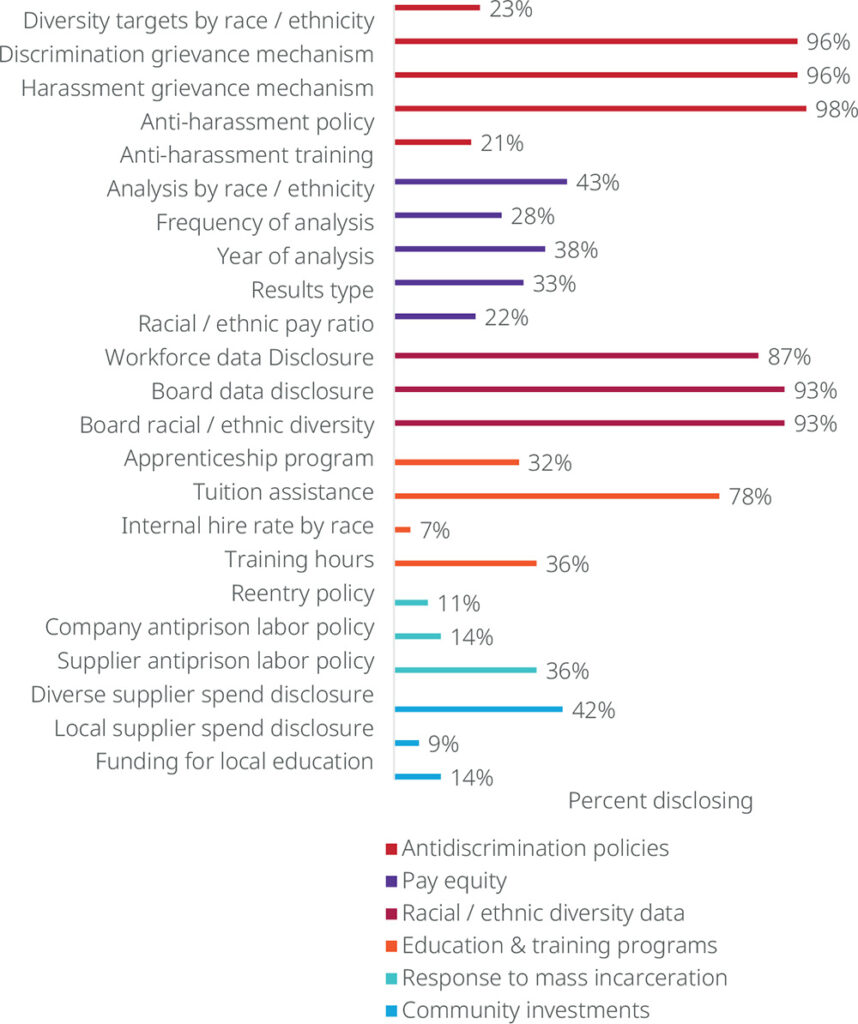
Figure 15: Percentage of America’s largest employers addressing racial equity in 2022, by metric | Source: Just Capital, 2022.
As we all know, providing metrics around DEIB won’t necessarily change everyone’s mind. However, by being clear about where the organization is on DEIB and why specific metrics are being shared versus others, leaders can start to build trust with employees. Over time, regular disclosures of metrics—and improving those metrics—can strengthen employees’ trust in this topic.
Conclusion
The time is now for DEIB leadership
Here & now
The last few years created a unique set of conditions that made people, organizations, and society more open to making meaningful changes to diversity, equity, inclusion, and belonging than ever before.
Create a holistic DEIB system
While it remains crucial that you create DEIB strategies aligned to specific needs, you also need to create alignment across the entire DEIB system— from “why” the organization focuses on DEIB down to leaders’ data, analytics, and metrics. This will create a much more cohesive and stronger system to support DEIB.
Be prepared
Our research indicates that organizations need—and employees demand—to take action on DEIB. By creating an aligned DEIB system (see Figure 16), your organization will be better prepared to tackle whatever comes next.

Stacia Garr

